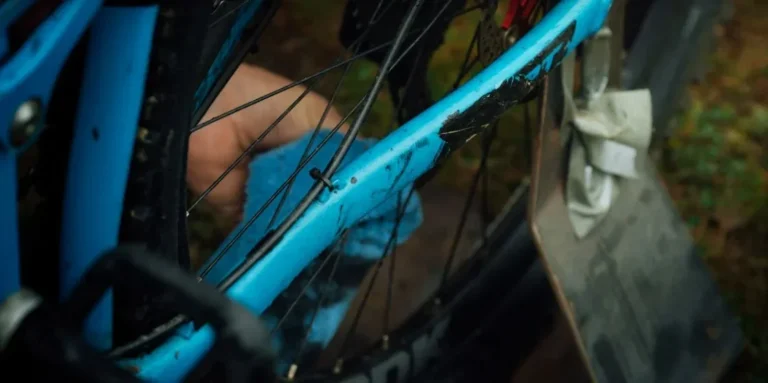Regardless of whether you are an experienced athlete or just starting, looking after your gear is crucial to ensure that it performs at its best and lasts longer. Properly maintaining your triathlon gear is an investment in your athletic performance, safety and enjoyment. In this article, we will provide you with tips and tricks to help you get the most out of your gear.
1. Swim gear
Cleaning your wetsuit
After each use, rinse your wetsuit with clean water and use a wetsuit cleaner to remove any salt, sand, or dirt that may have accumulated. Use a soft-bristled brush to clean the suit gently, being careful not to damage the neoprene material. After washing, rinse the suit thoroughly with fresh water and hang it to dry.
Drying your wetsuit
Drying your wetsuit correctly is essential to maintain its shape and integrity. To dry the wetsuit, hang it in a shaded and ventilated area. Avoid hanging the wetsuit in direct sunlight or using a dryer as the high heat can damage the neoprene.
Storing your wetsuit
Before storing your wetsuit, make sure it is completely dry. Folding or crushing the wetsuit can damage the neoprene, so store it flat or hanging. It’s best to store the wetsuit in a cool, dry, and dark area to protect it from sunlight and extreme temperatures.
Swimming goggles
After each use, rinse your swimming goggles with clean water to remove any chlorine, salt, or dirt that may have accumulated. Use a soft cloth or your fingers to clean the lenses gently, being careful not to scratch or damage them. Rinse the goggles thoroughly with fresh water and allow them to air dry. You can also use soap especially made for swimming googles.
Storing your goggles
To prevent scratches or damage to the lenses, store your goggles in a protective case. Avoid leaving the goggles exposed to direct sunlight or extreme temperatures, as this can damage the lenses and affect their clarity.
Replacing your goggles
Replace your goggles if they become scratched, foggy, or damaged. Worn-out goggles can affect your visibility and performance and can be a safety hazard. It is recommended to replace them every 6-12 months, depending on how often you use them. Always carry a spare pair of goggles in your triathlon bag, just in case.
2. Bikes
Cleaning your bike
Cleaning your bike is an important part of maintaining its performance and prolonging its lifespan. Use a bike-specific cleaning solution and a soft-bristled brush to clean the bike’s frame, wheels, and other components. Make sure to remove any dirt, grime, or mud from the bike’s chain and derailleurs.
Lubricating your bike
Lubricating your bike’s chain and other moving parts is crucial to keep it running smoothly. Use a bike-specific lubricant and apply it to the chain, derailleurs, and other moving parts. Be sure to wipe off any excess lubricant to avoid attracting dirt and grime.
Inspecting your bike
Regularly inspecting your bike can help you identify any issues before they become more significant problems. Check the tires for any signs of wear or punctures and inspect the brakes and cables to ensure they are functioning correctly.
3. Running Shoes
Cleaning your shoes
Cleaning your running shoes can help them last longer and maintain their performance. Use a soft-bristled brush and a mild detergent to clean the shoes gently. Avoid using a washing machine, as this can damage the shoes.
Drying your shoes
After cleaning, allow your shoes to dry completely before wearing them again. Stuffing the shoes with newspaper or using a shoe dryer can help to speed up the drying process.
Replacing your shoes
Running shoes should be replaced every 300-500 miles, depending on the manufacturer’s recommendations. Worn-out shoes can cause discomfort, pain, and even injury. Pay attention to any signs of wear or discomfort and replace your shoes accordingly.
4.Tri-Suits
Washing your tri-suit
After each use, wash your tri-suit with a gentle detergent to remove any sweat, dirt, or grime. Avoid using fabric softeners or bleach, as these can damage the suit’s material.
Drying your tri-suit
Hang your tri-suit to dry in a cool, dry, and shaded area. Avoid using a dryer or direct sunlight, as these can damage the fabric and reduce the suit’s lifespan.
Storing your tri-suit
Store your tri-suit in a cool, dry, and dark place to protect it from sunlight and extreme temperatures. Avoid storing the suit in a compressed or folded position, as this can damage the fabric and affect the suit’s performance.
5. Importance of Proper Maintenance
Saving money
Properly maintaining your triathlon gear can help you save money in the long run by extending the lifespan of your gear and reducing the need for costly repairs or replacements.
Enhancing performance
Maintaining your gear can help you perform at your best by ensuring that your equipment is in optimal condition. Properly maintained gear can help you feel more comfortable, reduce the risk of injury, and improve your performance.
Ensuring safety
Maintaining your gear can help ensure your safety while competing. Worn-out or damaged gear can be a safety hazard and increase the risk of injury or accidents.
The bottom line
In conclusion, proper maintenance of your triathlon gear is essential to ensure it performs at its best and lasts longer. By following these tips and tricks, you can keep your gear in top shape and enhance your athletic performance. Proper maintenance not only saves you money but also ensures your safety and comfort during races. Take action and make sure to maintain your gear regularly to get the most out of your triathlon experience.






